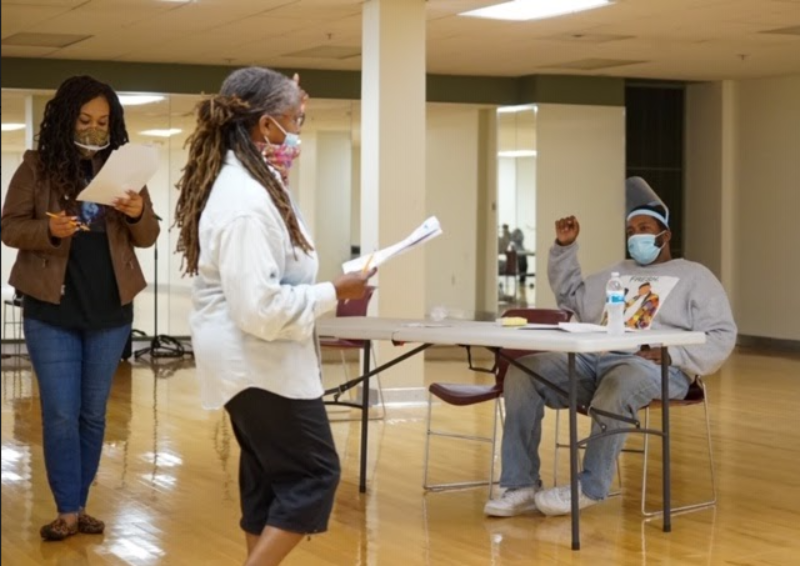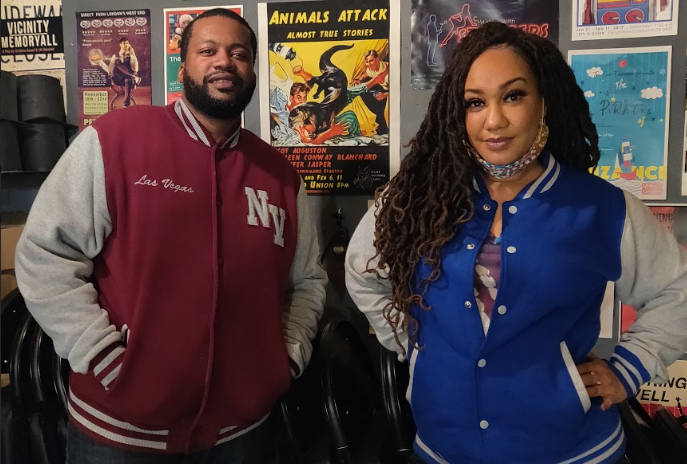I Dream Of COVID-19: The Evolution of Theatre in the Age of Coronavirus
Review of COVID Dreams at 18th and Union
Written by Teen Writer Audrey Liepsna Gray and edited by Teen Editor Lucia McLaren

On March 23, 2020, Governor Jay Inslee issued the first stay-at-home order for Washington state in response to COVID-19. Plans were canceled, events were rescheduled. Inslee tentatively scheduled the first shutdown to last at least two weeks, but now self-quarantine and social distancing have been going on for seven months with hardly any sign of stopping. Being alone with ourselves has made things bleak and dire, and for artists all across the country, COVID-19 has signaled a substantial shift in the way we direct our creative energy. Forced out of venues but fueled by the crises of our day, a brilliant example of the adaptability of art has been revealed by the quarantine. Out of the ashes of the on-hold artistic scenes across the country, new art has emerged with new formats made for safety and perfected for the current age. COVID Dreams, a new play from Radial Theater Project and 18th & Union Seattle, is a perfect example of the evolution art has gone through in the one-of-a-kind time we’re living in.
COVID Dreams, directed by Merri Ann Osborne and written by Jacqueline Ware, is a part of a new era of innovative theatre that’s emerged during quarantine. It combines the necessary precautionary measures now needed to produce art with the easy intimacy and emotion of live production, despite the lack of an in-person audience. The play follows the conversation and personal connection between two college students as they wait for their professor to arrive for class and find themselves the only ones there. During the wait, they engage in lively talks about their lives in the age of coronavirus and impromptu a cappella performances about the stresses that consume their days. I had the amazing privilege to be able to talk with Osborne and Ware about COVID Dreams and gain insight into the world of play production and inspiration in quarantine. I quickly realized it’s been very strange and very, very limited.
“There were so many criteria. One was how the play was written, it had to be one to two people… You have to write the play while thinking of social distancing in it, like six feet apart, et cetera,” Osborne said about the production. “When we staged this particular play, we really had to put that into action, and talk to the actors about staying six feet apart and wearing masks.”
The play is conscious of its social distancing, with the two actors wearing masks and face guards and standing six feet apart on the small stage. The staff rigorously disinfects the theater space after the livestream of the show, and all the guidelines and restrictions put in place for the writing and production of the play are followed to the letter. Almost any other play would feel sterile and distant, like it didn’t belong with the rules. But COVID Dreams reformats the social distancing guidelines in a way that astonished me—it made the distance and copious restrictions seem like a benefit.
What made this play so brilliant and unique in its connection to the crises of our day was the sense of attachment to the characters. Isolation has made human interaction rare and brief, and COVID Dreams plays off of the neglected need for connection during quarantine by creating impactful narratives in an amazingly candid way with Traci (Ashanti Proctor) and Payne (CJ Dudley), the two main characters. They’re real, and they’re living. They could easily be any two people you see on the street, and the stories they tell of their pandemic-affected lives are mirrored in the lives of Americans today. The banter and effortlessly conveyed personalities of the characters are real because you see the same things that they discuss every day in your own life. There’s no disconnect—COVID Dreams is very much a play of the real world, so much that you almost forget you’re not there in the room with them, eavesdropping in on their discussion. Payne is worried about keeping his grandmother safe, who’s in the at-risk age group for COVID-19, speaking of all the joy she’s brought to his life. Traci is struggling to make ends meet for her and her son after she lost her job and had to move back in with her parents; she feels like she’s moving backward, and it concerns her. The stories are so personal and genuine that one of the questions I immediately had for Ware was how her own pandemic experiences had shaped her inspiration for the play, and I got an answer that I wasn’t expecting.

“As the playwright, my pandemic experience had to do with the dreams,” Ware said. She refers back to a tale told by the character Traci in the play, who described swarming bugs and giant bullfrogs in a disturbing nightmare she had. “I never did reveal this to the actors…but when it comes to the dream Traci had, I actually had a dream like that. It was so vivid, I couldn’t believe it.” What’s even stranger is that Ware read in a newspaper article about multiple people having these types of dreams full of disturbing imagery, especially featuring insects. “I felt like I wasn’t in that boat alone, having those strange, odd, uncomfortable dreams during this uncomfortable time.”
Recurring, bizarre nightmares are not at all uncommon—in fact, researchers believe they’re a healthy way for the human psyche to work out preoccupations and stressors from the day. Common dreams among hundreds of people have also been observed throughout the years, most notably after huge societal trauma from the events of 9-11, but the COVID-19 pandemic has seen by far the largest upwelling of mass nightmares ever. The phenomenon has been reported globally. Discomfort, loneliness, intense fear, paranoia—all these emotions have been swelling during the isolation of quarantine, and all are expressed in COVID Dreams. As you watch the conversation taking place on stage, the powerful connection forged between the characters is both infectious and relatable. The emotions you feel are being represented by everyday characters, and it’s through this representation and identification of emotion that COVID Dreams connects to its audience in such a seamless way. The original music, written by CJ Dudley and performed by him and Ashanti Proctor, only enhances the emotional impact of the play through the candid, heartfelt performances sprinkled in amongst the conversation. The music brings dimension to the characters and their struggles—it gives them creativity. The hope the characters find in music and art is mirrored in people everywhere, left unmotivated and dispirited by isolation. Creativity is what gives Traci and Payne the strength to get through their struggles and find optimism in their circumstances, and it’s part of what gives this play its emotional impression.
The final question I had for Ware and Osborne was what this play meant to them. Ware responded, “To me, it means the goal I had with this play was accomplished. I had a goal to bring light, and life, and energy, and positivity to a space…It means I have impacted someone, hopefully, in a positive way, where they’re going to walk away from this play feeling a little bit lighter, a little bit happier, having a little bit more joy.” Her goal was fulfilled through COVID Dreams. Even with the undeniable sobriety of its subject matter, the play manages to evoke joy and laughter through the connection of the characters, the humanity of their challenges, and the honest hope felt in the enthusiastic musical numbers. It couldn’t have been expressed better.
Over anything else, COVID Dreams reveals the strength of humanity and artistic vision during these trying times. “Art is essential. It’s so therapeutic…it spans so many genres. It helps to center you, and helps you navigate through this extremely disconnecting time,” Ware told me. Since the beginning of quarantine, art has been expanding. Films are being screened and released. Books are being written. Paintings are being made. This play is one of the first written for the pandemic, of the pandemic, and put on with pandemic-minded safety guidelines.
“To me, there is no replacing a theatrical performance live. Because you cannot replace Broadway, and 42nd Street, you can’t replace these experiences…but I don’t think this (the virtual format) replaces anything. I think it enhances what we’re doing,” Osborne explained. COVID Dreams and other virtual plays made during quarantine are emerging as a bona fide new format of theatre, created by necessity and safety, and spurred on by inspiration and passion. But just as COVID Dreams is an epitomic example of the changes art has gone through since the beginning of quarantine and the world’s isolation, it also embodies how art hasn’t changed one bit. Art will continue to grow through new mediums and new challenges, and although it will evolve, it will always be the same in its ability to guide, evoke emotion, and help us understand ourselves and the world around us.
COVID Dreams was part of 18th & Union's Pandemic Plays series, and was performed October 8-23, 2020. For more information see here.
Lead photo credit: Rehearsal photo of COVID Dreams. Photo by Jacqueline Ware.
The TeenTix Newsroom is a group of teen writers led by the Teen Editorial Staff. For each review, Newsroom writers work individually with a teen editor to polish their writing for publication. The Teen Editorial Staff is made up of 6 teens who curate the review portion of the TeenTix blog. More information about the Teen Editorial Staff can be found HERE.
The TeenTix Press Corps promotes critical thinking, communication, and information literacy through criticism and journalism practice for teens. For more information about the Press Corps program see HERE.


